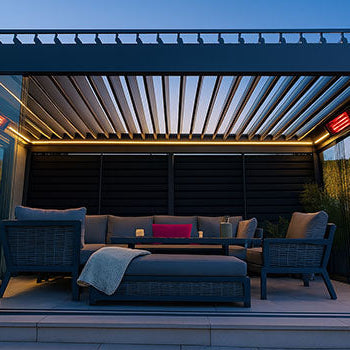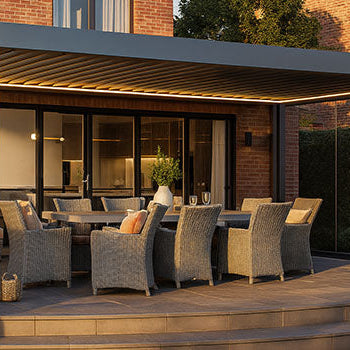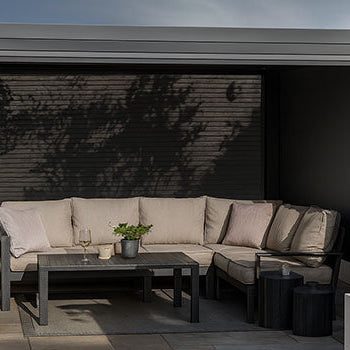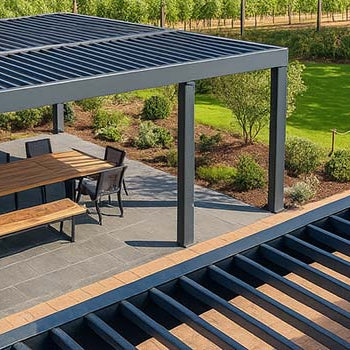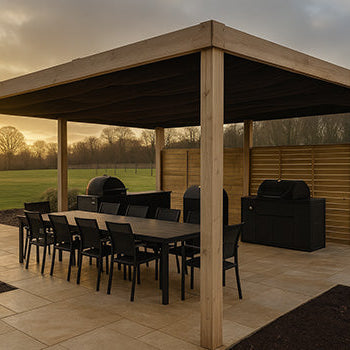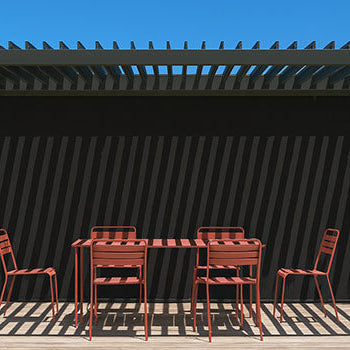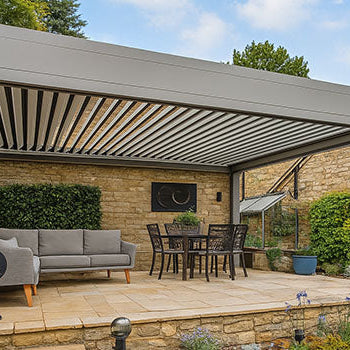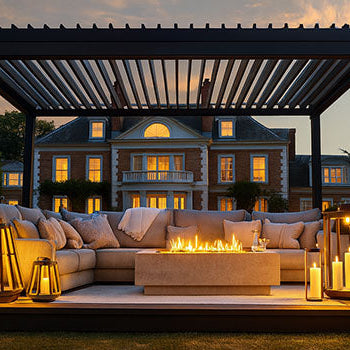Rainy BBQ ruined again? Pergolas might look sleek, but they’re not waterproof by default. That dreamy garden setup? It turns into a splash zone the moment the clouds roll in. But don't give up on outdoor living just yet. With the right upgrades, your pergola can stand up to the rain like a champ. Let’s show you how to make your pergola both stylish and storm-ready.

The Straight Answer: Are Pergolas Naturally Waterproof?
Understanding the Traditional Pergola Design
Pergolas were never built to block rain. Think of them like outdoor picture frames for your garden, decorative, open, and full of charm. Most classic pergolas feature wooden or metal beams spaced apart, giving you that beautiful light-and-shade play.
But when the weather turns, so does their usefulness.
They’re great for dappled sunlight, but rain? Not so much. A traditional pergola leaves you and your furniture wide open to the elements.
Why an Open-Top Pergola Doesn't Block Rain
Here’s the reality: open-roof pergolas don't stop rain, they invite it in. The gaps between slats let water through easily. So if you're wondering "are pergolas rain proof?" the answer is a hard no, unless you've made some modifications.
When it rains on a standard pergola, expect soggy seat cushions, puddles on the patio, and a quick retreat indoors. The good news? There are plenty of clever ways to fix that.
How to Make a Pergola Waterproof: Your Best Options
Option 1: Installing a Solid Polycarbonate Roof
If you love light but hate getting wet, polycarbonate panels are your best friend. These sheets are clear, UV-resistant, and super tough, making them a great fit for unpredictable British weather.
You still get that bright, airy feel, but now without the rain. Plus, they’re relatively easy to install and don’t add too much weight to your pergola structure.
Option 2: Using Corrugated Roofing Sheets
For something cheap and cheerful, try corrugated roofing sheets. They come in plastic or metal, and they do the job when it comes to blocking rain.
They’re not the prettiest option, but they’re functional and widely used for practical outdoor setups. If you're after a quick waterproof pergola UK solution, this is it.
Option 3: Adding a Retractable Waterproof Canopy
Want flexibility? Go for a retractable rain cover for your pergola. When it’s sunny, pull it back and let the light in. When it rains, roll it out and stay dry.
You can find sleek, modern designs that blend right in with your garden style. It's like having an umbrella on standby for your entire patio.
Option 4: Upgrading to a Louvered Roof Pergola System
Now we’re talking top tier. Louvered roof systems let you control the slats with a remote, open them for airflow or close them completely when it rains.
Some even come with rain sensors that auto-close when the skies open up. It’s a premium solution, but it gives you year-round control and a modern, high-end look.

Comparing Waterproof Roofing Solutions
Cost vs. Effectiveness
Here’s a quick breakdown to help you choose:
-
Polycarbonate panels: £250-£500 | Lasts 10-15 years | Great light + rain protection
-
Corrugated sheets: £100-£300 | Lasts 5+ years | Budget-friendly
-
Retractable canopies: £500-£1500 | Lasts 7-10 years | Best for flexibility
-
Louvered systems: £1500+ | Lasts 10+ years | Premium control and style
Aesthetics and Style Considerations
-
Want something modern? Go for a louvered pergola or retractable canopy.
-
Prefer classic charm? Polycarbonate panels blend well with wood or painted metal.
-
On a tight budget? Corrugated sheets will do the trick, but may not win design awards.
Permanent vs. Flexible Solutions
Some pergola waterproofing options are permanent fixes. Others let you change things up.
Polycarbonate and corrugated roofs stay put. They offer year-round coverage, but less flexibility.
Retractable and louvered roofs adapt to your mood and the weather, sunny one minute, stormy the next? You're covered either way.
The Pros and Cons of a Waterproof Pergola
The Benefits of All-Weather Outdoor Living
Once waterproofed, your pergola becomes a multi-season garden haven. You can dine, relax, or entertain without checking the forecast every five minutes.
It also protects your outdoor furniture, adds value to your home, and gives you more use from your garden space.
Potential Drawbacks: Reduced Light and Airflow
Here’s the trade-off. Some roofing solutions can block light or airflow.
Solid roofs reduce that open, breezy feel, especially with darker materials. If that’s important to you, go for clear panels or retractable options to keep things bright and breathable.

Frequently Asked Questions About Waterproofing Pergolas
Can you waterproof an existing wooden pergola?
Yes! Most wooden pergolas can be upgraded with waterproof panels, canopies, or even retractable roof systems.
Add sealants or weather-resistant coatings to protect the wood, and you’re good to go.
What is the cheapest way to waterproof a pergola?
Corrugated plastic roofing or heavy-duty waterproof tarps are your cheapest options. Not the fanciest, but they’ll stop the rain. Ideal for quick DIY fixes or rental properties.
Does a waterproof roof require more maintenance?
Yes, a bit. You’ll need to clear leaves and debris regularly and check seals or fixings for wear. Retractable canopies and moving systems may also need seasonal cleaning or small repairs.
But the payoff? A dry, usable space all year round.
So, are pergolas waterproof? Not on their own. But with the right upgrade, you can enjoy your pergola through all four seasons. Whether you DIY it with panels or go high-end with smart tech, there’s a waterproof solution to suit every style, budget, and British forecast.
